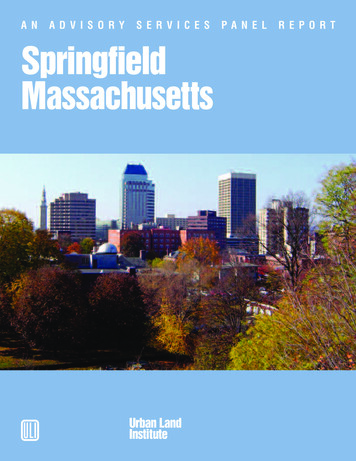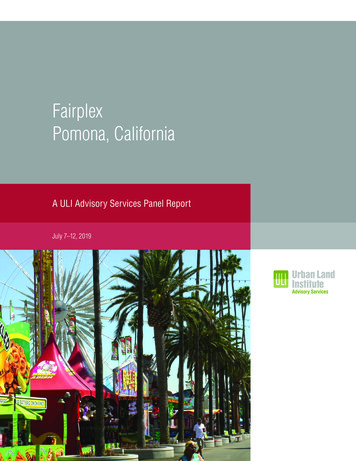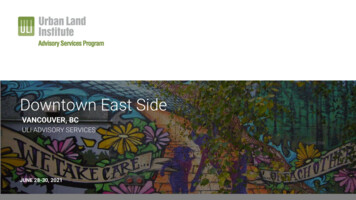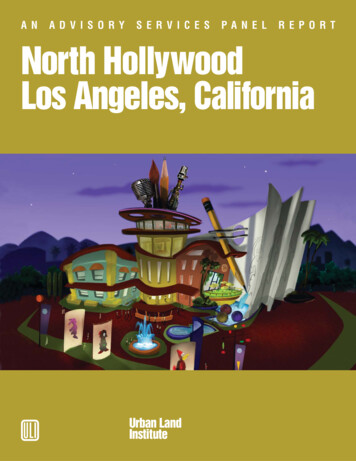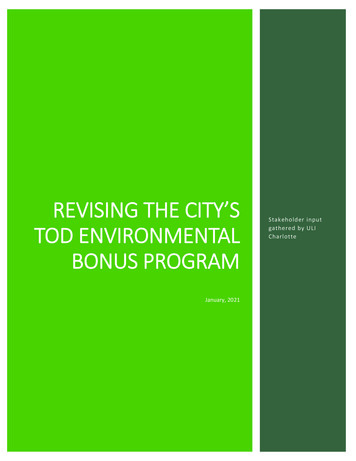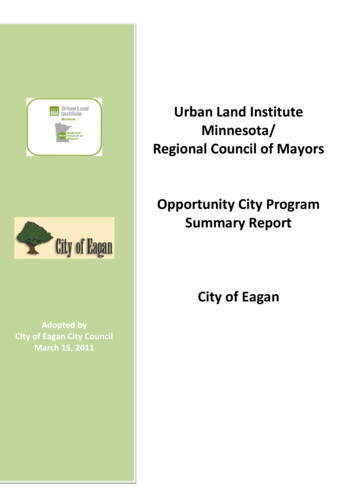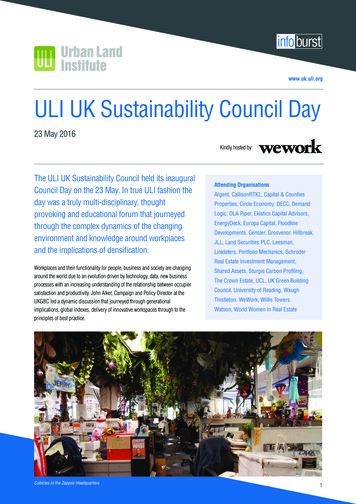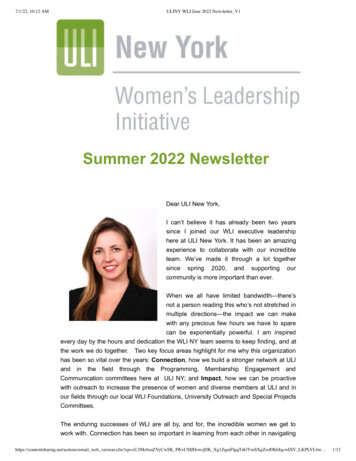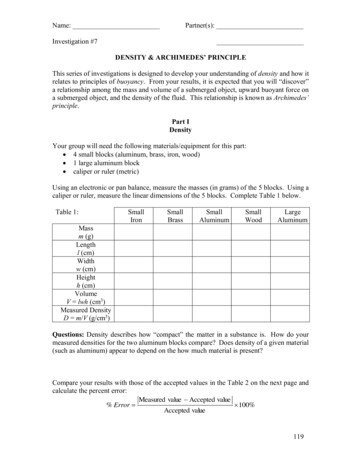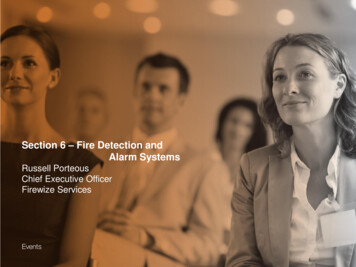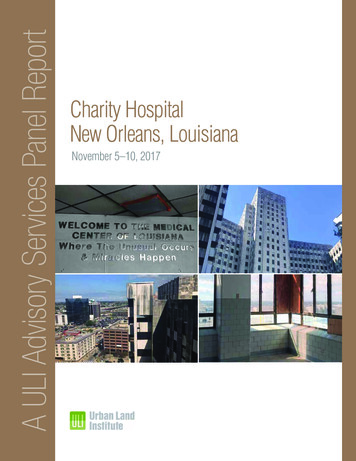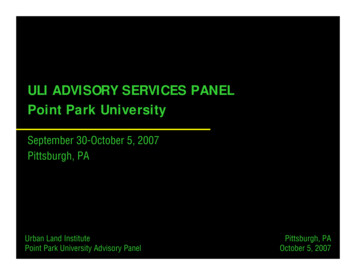
Transcription
ULI ADVISORY SERVICES PANELPoint Park UniversitySeptember 30-October 5, 2007Pittsburgh, PAUrban Land InstitutePoint Park University Advisory PanelPittsburgh, PAOctober 5, 2007
IntroductionLeigh FergusonSloss Real Estate, Birmingham, ALUrban Land InstitutePoint Park University Advisory PanelPittsburgh, PAOctober 5, 2007
ULI—The Urban Land InstituteULI–the Urban Land Institute is a nonprofit research andeducation organization.Mission:Promote leadership in the responsible use of land to create andsustain thriving communities worldwide.Urban Land InstitutePoint Park University Advisory PanelPittsburgh, PAOctober 5, 2007
Advisory ServicesAssembles teams of land use professionals to make strategicrecommendations on land use challenges. Program started in 1947 20-30 panels each year Teams composed of ULI members Panels organized across the countryUrban Land InstitutePoint Park University Advisory PanelPittsburgh, PAOctober 5, 2007
The Panel Process Define the scope of the assignmentPrepare background briefing materialsAssemble the expert teamTour the siteInterview stakeholdersDebate and form recommendationsProduce a final reportUrban Land InstitutePoint Park University Advisory PanelPittsburgh, PAOctober 5, 2007
The Assignment“Point Park University’s goal is to create a strong, vibrantcampus experience that complements the strong academicexperience while being a respectful member of the surroundingcommunity that is part of Downtown Pittsburgh. The successof the campus will be the success of the neighborhood and viceversa.“The challenge is: How can Point Park University engagedowntown stakeholders and residents to create a new, dynamicneighborhood along Wood Street and the Boulevard of theAllies that complements other downtown districts?Urban Land InstitutePoint Park University Advisory PanelPittsburgh, PAOctober 5, 2007
The PanelChair:Market:Development Strategies:Planning and Design:Implementation:Urban Land InstitutePoint Park University Advisory PanelLeigh FergusonBelinda SwardChris LambertPeter SmirniotopoulosBrian JonesAdam KromOtto CondonTerry FoeglerJohn Gunther-MohrPittsburgh, PAOctober 5, 2007
Sponsors Point Park University Commonwealth of Pennsylvania, Department of Community andEconomic Development Allegheny County Department of Economic Development The Urban Redevelopment Authority of the City of Pittsburgh The Heinz EndowmentsUrban Land InstitutePoint Park University Advisory PanelPittsburgh, PAOctober 5, 2007
Special Thanks Paul HenniganMarianne GeyerSheila RawlingsPoint Park University studentsCommunity members who shared their ideas with the panelUrban Land InstitutePoint Park University Advisory PanelPittsburgh, PAOctober 5, 2007
Defining the Study AreaStudy AreaUrban Land InstitutePoint Park University Advisory PanelPittsburgh, PAOctober 5, 2007
This Morning’s Program IntroductionMarket PotentialDevelopment StrategiesPlanning and DesignImplementationConclusionQuestion and AnswerUrban Land InstitutePoint Park University Advisory PanelPittsburgh, PAOctober 5, 2007
Market PotentialBelinda SwardNewland Communities, San Diego, CAChris LambertBrailsford and Dunlavey, Washington, DCUrban Land InstitutePoint Park University Advisory PanelPittsburgh, PAOctober 5, 2007
Background Downtown retail supply exceeds demand by 298,000 squarefeet of gross leaseable area (GLA) This gap suggests that many existing stores may fail to achievetarget sales, require subsidies, and be in risk of closing Increasing support for downtown retail will require increasingthe downtown population and growing the downtown workforceUrban Land InstitutePoint Park University Advisory PanelPittsburgh, PAOctober 5, 2007
University Retail Support Current GLA in university-owned buildings totals 6,000 squarefeet, including the bookstore and Starbucks Recent and anticipated building acquisitions will grow theuniversity’s GLA to 30,000 square feetUrban Land InstitutePoint Park University Advisory PanelPittsburgh, PAOctober 5, 2007
Analysis of Student Expenditures The university anticipates a 3% annual enrollment increase A majority of full-time underclassmen will purchase a meal plan.Population20072012Annual Retail ainmentUniversityStudents3,5924,193Full-Time, lessmeal plan2,0432,385 900 1,184 1,654 3,738Other Students 1,5491,808 900 3,264 1,654 5,818Urban Land InstitutePoint Park University Advisory PanelPittsburgh, PAOctober 5, 2007
Student Spending in the Study Area Typically, students only make a portion of their expenditures in thecampus area where they live, especially for clothing. Currently, a very low percentage of students live on campus. The panel assumed only 10% of the expenditures are near campus The university can grow student expenditures and retail demand byincreasing the number of students living on-campus.Population Total Annual PercentExpenditures in Area2007Total AnnualExpenditures in Area3,592 16,648,816 10% 1,664,882Full-Time, less meal plan 2,043 7,636,734 7,636,734Other Students 9,012,082 9,012,082University Students1,549Urban Land InstitutePoint Park University Advisory PanelPittsburgh, PAOctober 5, 2007
Current Retail Demand Assuming a conservative sales target of 150 per GLA, currentstudent demand will support a total 11,000 square feet of GLAPopulation Total Annual2007Expendituresin AreaUniversity Students3,592Urban Land InstitutePoint Park University Advisory Panel 1,664,882AverageSales/GLA 150GLASupported11,099Pittsburgh, PAOctober 5, 2007
Current Retail Demand Most retailers target a minimum of 300 to 350 per GLA tosupport their store. Pittsburgh’s current downtown market onlyachieves around 125 to 150 per GLA in sales on average. Based on a healthy sales target of 300 per GLA, currentenrollment can only support 5,500 square feet of GLA.Urban Land InstitutePoint Park University Advisory PanelPittsburgh, PAOctober 5, 2007
Future Demand Potential Assuming expected enrollment growth of 3% per year,increased on campus living, and a 300 per GLA sales target,there will be support for 16,000 square feet of GLA by e, lessmeal plan2,385Other Students1,808Percentin Area25%Urban Land InstitutePoint Park University Advisory PanelTotal AnnualExpendituresin Area 4,858,608AverageSales/GLAGLASupported 15032,391 30016,185Pittsburgh, PAOctober 5, 2007
Other Retail Demand Increased downtown workers, downtown non-student residents,and visitors can provide additional support for an additional 5,000square feet of retail. The panel cautions that the above should be growth in these sectorsversus taking sales away from existing stores. More housing will create more retail demand. The city anduniversity should pursue a downtown housing strategy and the cityshould pro-actively strengthen the downtown workforce. Events strategies are proven tools to bolster retail health byextending people’s stays and increasing expenditures. Events caninclude outdoor performances, music, and arts-related events.Urban Land InstitutePoint Park University Advisory PanelPittsburgh, PAOctober 5, 2007
Office Space There is minimal net support for new office space within theuniversity buildings beyond the university’s direct needs. Much of this will include university related support servicessuch as printing, production, and other small businesses,including start-ups. The panel believes there could be potential support forapproximately 4,000 to 6,000 square feet of space.Urban Land InstitutePoint Park University Advisory PanelPittsburgh, PAOctober 5, 2007
Retail and Office Summary The panel believes that there is potential support for 16,000 upto 20,000 square feet of street level retail and small officespaces in the University’s academic and residential buildings inapproximately 5 years. This assumes:– Doubling the number of students who live on and adjacentto campus– Generating potential from non-student demand– Increasing the percent of student expenditures in theUniversity area, which may or may not occur and dependson the store mix and increase in out-of-state students.Urban Land InstitutePoint Park University Advisory PanelPittsburgh, PAOctober 5, 2007
Retail Store Types and Locations Given that the majority of support will emanate from universitystudents and the university, stores could include:– University bookstore and supplies– Small pharmacy, personal needs, and clothing related– Coffee, sandwich, deli, pizza and similar– Bars and entertainment– Movies Preferred locations are along Wood Street or First Avenueversus Boulevard of the Allies, which the panel believes doesn’tlend itself for retail.Urban Land InstitutePoint Park University Advisory PanelPittsburgh, PAOctober 5, 2007
Retail Character The character of the retail experience should be both fun andsafe, with opportunities for learning and appropriately pricedofferings. Indoor and outdoor space should be designed with music andfurnishings that create third places for students and how theylive today. The retail character should complement and serve thesurrounding community.Urban Land InstitutePoint Park University Advisory PanelPittsburgh, PAOctober 5, 2007
Demand for Housing and Recreation Methodology– Analyzed Demographics university enrollment projections Age and student class full-time/part-time status location of home residence retail spending capacity– Benchmarked the University against comparableinstitutionsUrban Land InstitutePoint Park University Advisory PanelPittsburgh, PAOctober 5, 2007
Housing Demand: Undergraduates2006 2007 2008 2009 2010 2011 2012 2013Full-Time 2,497 2,499 2,618 2,723 2,817 2,906 2,988 6696%-3%6934%6%5%4% 11%4%3,546 3,592 3,706 3,827 3,941 4,083 4,193 4,3001%3%3%3%4%3%3%Urban Land InstitutePoint Park University Advisory PanelPittsburgh, PAOctober 5, 2007
Housing Demand: Undergraduates Demographics– 17% of undergraduates from outside Pennsylvania.– Increasing share of undergraduates from outside Pittsburgh– 67% of undergraduates are traditional age (18-24 years old).Urban Land InstitutePoint Park University Advisory PanelPittsburgh, PAOctober 5, 2007
Housing Demand: Undergraduates Benchmarking / Trends– Many universities offer on-campus housing for well in excess of ½of student body. Capture rates for underclassmen on campuses with “live-on”policies typically in the ninety-percentile range. Capture rates even for upperclassmen often exceeds 30% andmay approach 50%.– Examples: Regional Western PA Universities – IUP, WCU, etc. Smaller Urban Private Colleges – Meredith, Davidson, etc.Urban Land InstitutePoint Park University Advisory PanelPittsburgh, PAOctober 5, 2007
Housing Demand: Undergraduates Benchmarking / Trends– Continuum of Unit Types (integrate with following slide)1356TraditionalSingle22BR Suite Double44BR Apartment Single2BR FamilyApartment2BR SemiSuite DoubleUrban Land InstitutePoint Park University Advisory Panel2BR SemiSuite SinglePittsburgh, PAOctober 5, 2007
Housing Demand: Undergraduates Net Demand– Gross Demand in 2007– Existing– Net Unsatisfied DemandUrban Land InstitutePoint Park University Advisory Panel1,500740760Pittsburgh, PAOctober 5, 2007
Housing Demand: Others Demographics– Enrollment growth requires corresponding level of facultyand staff employment growth. The University has hired 26 full time faculty alone 13/year - in past 2 years. Very limited supply of downtown housing affordable –especially for younger faculty.Urban Land InstitutePoint Park University Advisory PanelPittsburgh, PAOctober 5, 2007
Housing Demand: Others Benchmarking / Trends– Workforce housing projects seen across nation in recentyears to provide affordable below-market rental and for-salehousing.– Many universities now offer housing as a recruitment andretention incentive/amenity.– Successful examples: Urban Universities: GMU, GW, NYU, etc. Many UC and other California campusesUrban Land InstitutePoint Park University Advisory PanelPittsburgh, PAOctober 5, 2007
Housing Demand: Others Some market exists for university-controlled housing forgraduate students and faculty/staff The University should not develop for the off-campuscommunity at this point in timeUrban Land InstitutePoint Park University Advisory PanelPittsburgh, PAOctober 5, 2007
Recreation Facilities– Nationally, universities increasingly userecreational spaces to help meet their missions: Recruitment of high quality students inincreasingly competitive environment. Wellness, recreation, and competitiveathletics needs of campus community. Community engagement.– Facilities provide range of spaces for: Competitive Athletics Organized and Drop-In recreation Wellness, Education, and RehabilitationUrban Land InstitutePoint Park University Advisory PanelPittsburgh, PAOctober 5, 2007
Development StrategiesPeter SmirniotopoulosUniDev LLC, Bethesda, MDBrian JonesForest City Commercial Group, Los Angeles, CAUrban Land InstitutePoint Park University Advisory PanelPittsburgh, PAOctober 5, 2007
Development PrinciplesPoint Park University should: Reinforce / expand core mission Consolidate / concentrate students and facilities Make campus more visible to strengthen function/reputation Use new, signature buildings to increase visibility Preserve rather than defer future growth opportunities Lead the revitalization of Wood StreetUrban Land InstitutePoint Park University Advisory PanelPittsburgh, PAOctober 5, 2007
Creating a Campus Create a cohesive and compact campus– between Wood and Smithfield Streets– and between Fort Pitt Boulevard and Fourth AvenuePOINTPARKUNIVERSITYCAMPUSUrban Land InstitutePoint Park University Advisory PanelPOINTPARKUNIVERSITYCAMPUSPittsburgh, PAOctober 5, 2007
Creating a Campus Create a campus gateway– from the Smithfield Street Bridge,– including an iconic building visible from Smithfield StreetUrban Land InstitutePoint Park University Advisory PanelPittsburgh, PAOctober 5, 2007
Creating a Campus Develop a unique University gathering place– First Avenue between Smithfield and Wood Streets– Tenant storefronts with student-oriented retail– New student union/activities center will add vitalityUrban Land InstitutePoint Park University Advisory PanelPittsburgh, PAOctober 5, 2007
Creating a Campus Create an urban academic village with 1,500 residents– 741 existing students beds within proposed campus– Add 760 new student bedsUrban Land InstitutePoint Park University Advisory PanelPittsburgh, PAOctober 5, 2007
Creating a Campus Clearly define boundaries with:– streetscape improvements– consistent architecturalvocabulary of universitybuildings– key intersectionsUrban Land InstitutePoint Park University Advisory PanelPittsburgh, PAOctober 5, 2007
Bring the Theater Home Pursue a joint venture with the Allegheny County IndustrialDevelopment Authority to develop the campus block along FortPitt Boulevard Develop an iconic theater complex at the Smithfield StreetBridge gateway into the campusUrban Land InstitutePoint Park University Advisory PanelPittsburgh, PAOctober 5, 2007
Create a Commons Develop student gathering and activity spaces along FirstAvenue between Wood and Smithfield Streets Consider purchasing the YMCA and adjacent properties tocreate student activity centerUrban Land InstitutePoint Park University Advisory PanelPittsburgh, PAOctober 5, 2007
Expand Student Housing Develop 759 additional beds in university-controlled residencehalls to increase the total student beds to 1,500 by 2013 Preserve and capitalize upon opportunities for other types ofhousingUrban Land InstitutePoint Park University Advisory PanelPittsburgh, PAOctober 5, 2007
Retail Space on Wood Street Create consistent streetscape and campus gateways Program with university-oriented uses Configure spaces to meet needs of incubator retailUrban Land InstitutePoint Park University Advisory PanelPittsburgh, PAOctober 5, 2007
Create a Consortium Partner with the neighboring Art Institute and Culinary Instituteto create a Neighborhood Arts Consortium The Consortium should help organize incubator restaurants,dance studios, galleries in Wood Street storefrontsUrban Land InstitutePoint Park University Advisory PanelPittsburgh, PAOctober 5, 2007
Manage the Corridor Establish neighborhood design and tenant design criteria toestablish a uniform character Use professional leasing, development, and managementexpertiseUrban Land InstitutePoint Park University Advisory PanelPittsburgh, PAOctober 5, 2007
Reality Check Retail space will not generate net revenue streams for theuniversity in the short-term The University should not pursue development of market-ratehousing on its properties Monitor the success of other projects and be prepared topursue new opportunities as they present themselvesUrban Land InstitutePoint Park University Advisory PanelPittsburgh, PAOctober 5, 2007
Development Goal “Create a strong vibrant campus experience to complement thestrong academic experience while being a respectful member ofthe surrounding community “The success of the campus will be the success of theneighborhood and vice versa.Urban Land InstitutePoint Park University Advisory PanelPittsburgh, PAOctober 5, 2007
Planning and DesignAdam KromWallace Roberts Todd, Philadelphia, PAOtto CondonZimmer Gunsul Frasca Architects, Washington, DCUrban Land InstitutePoint Park University Advisory PanelPittsburgh, PAOctober 5, 2007
Creating a New CampusUrban Land InstitutePoint Park University Advisory PanelPittsburgh, PAOctober 5, 2007
Campus Environment– Buildings (Street Walls)– Streets– Civic SpacesUrban Land InstitutePoint Park University Advisory PanelPittsburgh, PAOctober 5, 2007
Street Types Regional boulevard (Boulevard of the Allies) Neighborhood corridor (Wood St.) Local campus streets (the Avenues)Urban Land InstitutePoint Park University Advisory PanelPittsburgh, PAOctober 5, 2007
Existing ConditionsUrban Land InstitutePoint Park University Advisory PanelPittsburgh, PAOctober 5, 2007
Street Walls: University Buildings The University is a good steward of historic buildings. New buildings should be architecturally bold, but should alwayshonor the pedestrian.Urban Land InstitutePoint Park University Advisory PanelPittsburgh, PAOctober 5, 2007
Street Walls: Other Buildings Work with neighboring propertyowners to take advantage ofgrants and loans for façadeimprovements.Urban Land InstitutePoint Park University Advisory PanelPittsburgh, PAOctober 5, 2007
LightingUrban Land InstitutePoint Park University Advisory PanelPittsburgh, PAOctober 5, 2007
LightingUrban Land InstitutePoint Park University Advisory PanelPittsburgh, PAOctober 5, 2007
LightingUrban Land InstitutePoint Park University Advisory PanelPittsburgh, PAOctober 5, 2007
LightingUrban Land InstitutePoint Park University Advisory PanelPittsburgh, PAOctober 5, 2007
StreetscapeUrban Land InstitutePoint Park University Advisory PanelPittsburgh, PAOctober 5, 2007
Creating a Grand BoulevardUrban Land InstitutePoint Park University Advisory PanelPittsburgh, PAOctober 5, 2007
Creating a Grand BoulevardUrban Land InstitutePoint Park University Advisory PanelPittsburgh, PAOctober 5, 2007
GatewaysUrban Land InstitutePoint Park University Advisory PanelPittsburgh, PAOctober 5, 2007
Public ArtUrban Land InstitutePoint Park University Advisory PanelPittsburgh, PAOctober 5, 2007
Traffic CalmingUrban Land InstitutePoint Park University Advisory PanelPittsburgh, PAOctober 5, 2007
Public Space Should the University create new parks/ and or open space? Ifso, where and what amenities should they contain?Urban Land InstitutePoint Park University Advisory PanelPittsburgh, PAOctober 5, 2007
Why? Enhance the live/learn environment– Meeting people– Time between classes– Studying– PerformingUrban Land InstitutePoint Park University Advisory PanelPittsburgh, PAOctober 5, 2007
ConnectivityThe city and riverThe streetsThe campus front doorThe campus commonsThe vertical universityUrban Land InstitutePoint Park University Advisory PanelPittsburgh, PAOctober 5, 2007
Build Upon the City AssetsConnecting to the city and riverUrban Land InstitutePoint Park University Advisory PanelPittsburgh, PAOctober 5, 2007
Address the CityThe campus front door – entry plazaUrban Land InstitutePoint Park University Advisory PanelPittsburgh, PAOctober 5, 2007
A Lively CenterThe campus commonsUrban Land InstitutePoint Park University Advisory PanelPittsburgh, PAOctober 5, 2007
The Vertical UniversityEngage the riverUrban Land InstitutePoint Park University Advisory PanelPittsburgh, PAOctober 5, 2007
The Vertical UniversityPublic space: River views, terraces, and recreational rooftops Green roofsUrban Land InstitutePoint Park University Advisory PanelPittsburgh, PAOctober 5, 2007
The Vertical UniversitySemi-public space: dormitory common spaceUrban Land InstitutePoint Park University Advisory PanelPittsburgh, PAOctober 5, 2007
The Downtown LaboratoryAdjacent spaces: retail, galleries, performance, danceUrban Land InstitutePoint Park University Advisory PanelPittsburgh, PAOctober 5, 2007
The Academic Mission “on the streets”Exhibits and programming of public spaceUrban Land InstitutePoint Park University Advisory PanelPittsburgh, PAOctober 5, 2007
ImplementationTerry FoeglerCampus Partners, Columbus, OHJohn Gunther-MohrBank of Scotland, New York, NYUrban Land InstitutePoint Park University Advisory PanelPittsburgh, PAOctober 5, 2007
Point Park University as Catalyst Take a leadership role in downtown neighborhood– More than just real estate Alignment of interests– Vital downtown neighborhood– More housing– Quality Student Experience Note of caution:– Risks of speed– New responsibilitiesUrban Land InstitutePoint Park University Advisory PanelPittsburgh, PAOctober 5, 2007
Spearhead Community Planning Process Use institutional master plan tool– Ensure open public process– Clear set of design, zoning and development standards– Expedites future permits– Non University properties Community partnershipsUrban Land InstitutePoint Park University Advisory PanelPittsburgh, PAOctober 5, 2007
Financial Planning Demonstrate institutional financial commitmentSubstantiate funding needs for planned projectsFlexibilityDialogue with:– Foundations– City and Urban Redevelopment Authority– Major contributors– County, State and Federal grant sourcesUrban Land InstitutePoint Park University Advisory PanelPittsburgh, PAOctober 5, 2007
Demonstrate Progress Redevelop currently owned properties Physical improvements to public spaces Community outreach/partnership programs– Retail incubator program– Consortium arts programUrban Land InstitutePoint Park University Advisory PanelPittsburgh, PAOctober 5, 2007
Downtown as Laboratory for Learning Entrepreneurship program in connection with the School ofBusiness– Retail incubators and other spacesExecutive training programsPerformance programming in public spaces through theConservatoryExpand service learning opportunities– Pre-school, performing arts high school, social servicesUrban Land InstitutePoint Park University Advisory PanelPittsburgh, PAOctober 5, 2007
University Organization Requirements Organizational options– Internal office– Affiliated entity Leadership Internal staff resources– Manage planning process– Design and construction management– Coordinate outreach with community partners– Link community needs to academic learning opportunitiesUrban Land InstitutePoint Park University Advisory PanelPittsburgh, PAOctober 5, 2007
ConclusionUrban Land InstitutePoint Park University Advisory PanelPittsburgh, PAOctober 5, 2007
Questions?Urban Land InstitutePoint Park University Advisory PanelPittsburgh, PAOctober 5, 2007
Point Park University Advisory Panel Pittsburgh, PA October 5, 2007 Analysis of Student Expenditures † The university anticipates a 3% annual enrollment increase † A majority of full-time underclassmen will purchase a meal plan. Other Students 1,549 1,808 900 3,264 1,654 5,818
